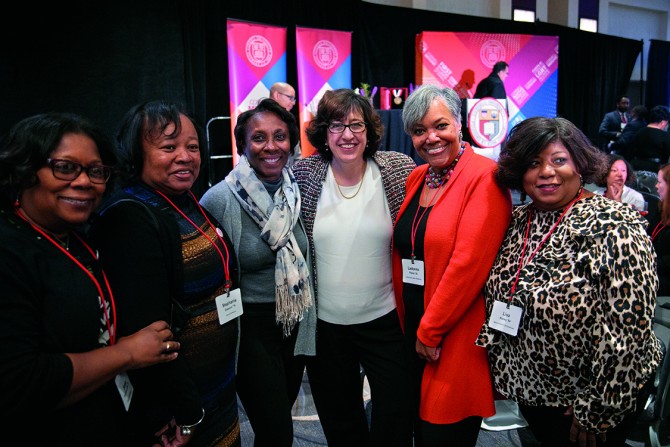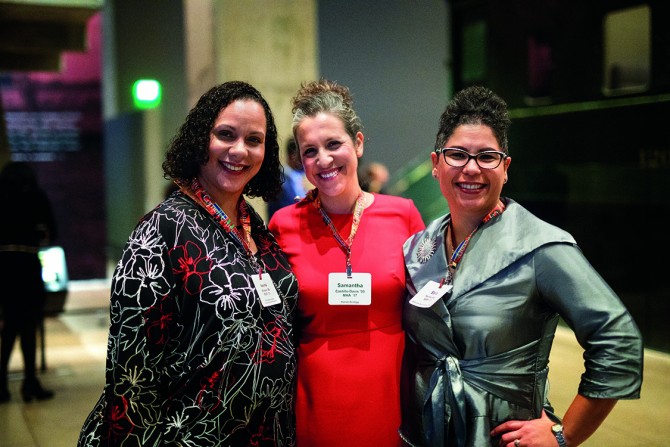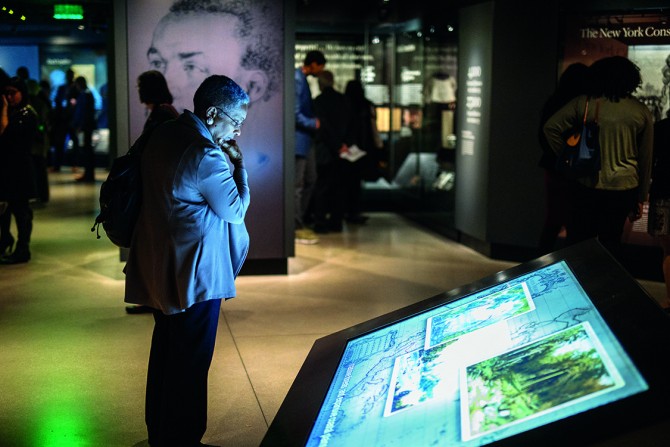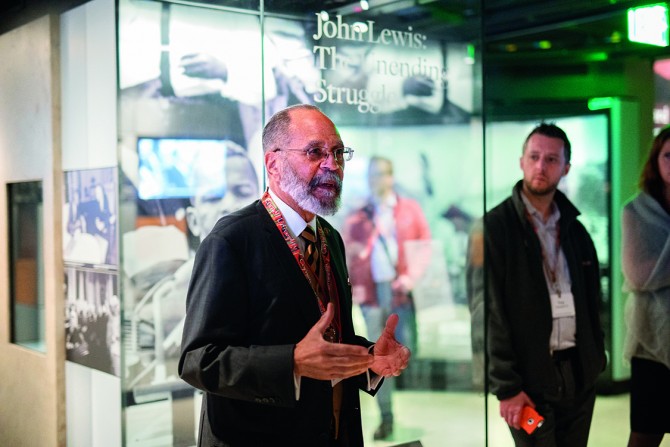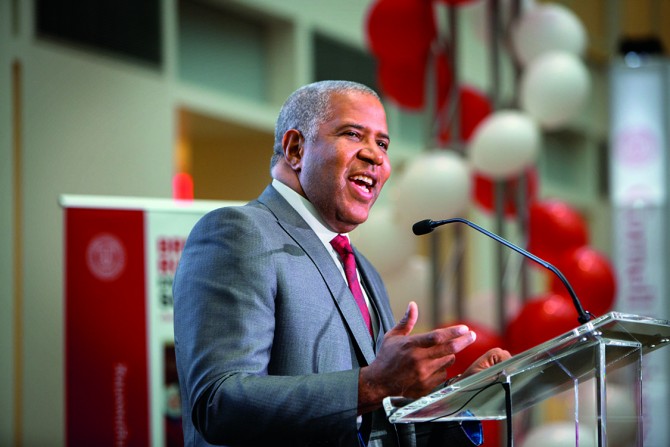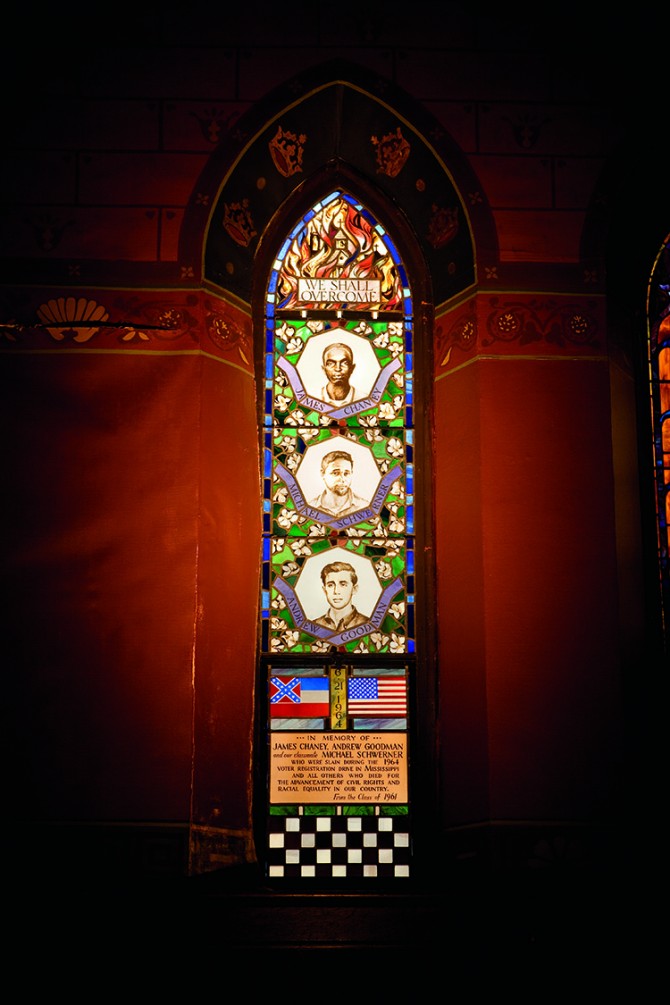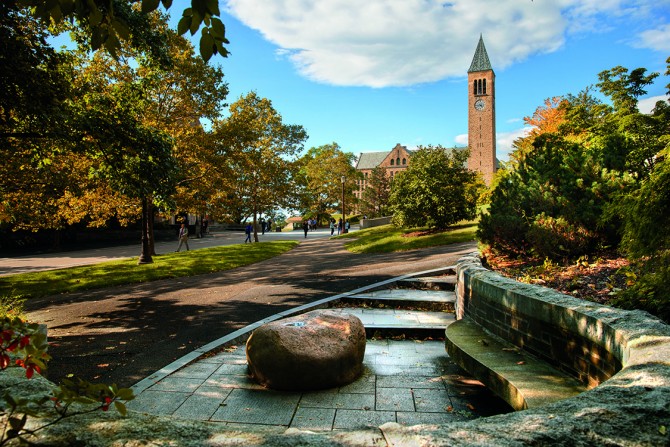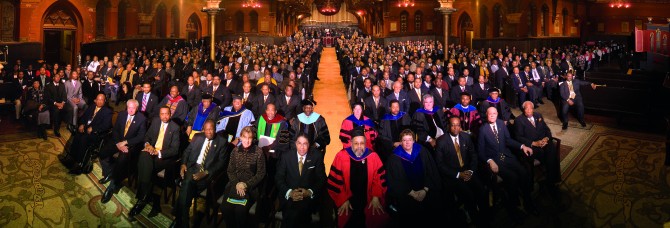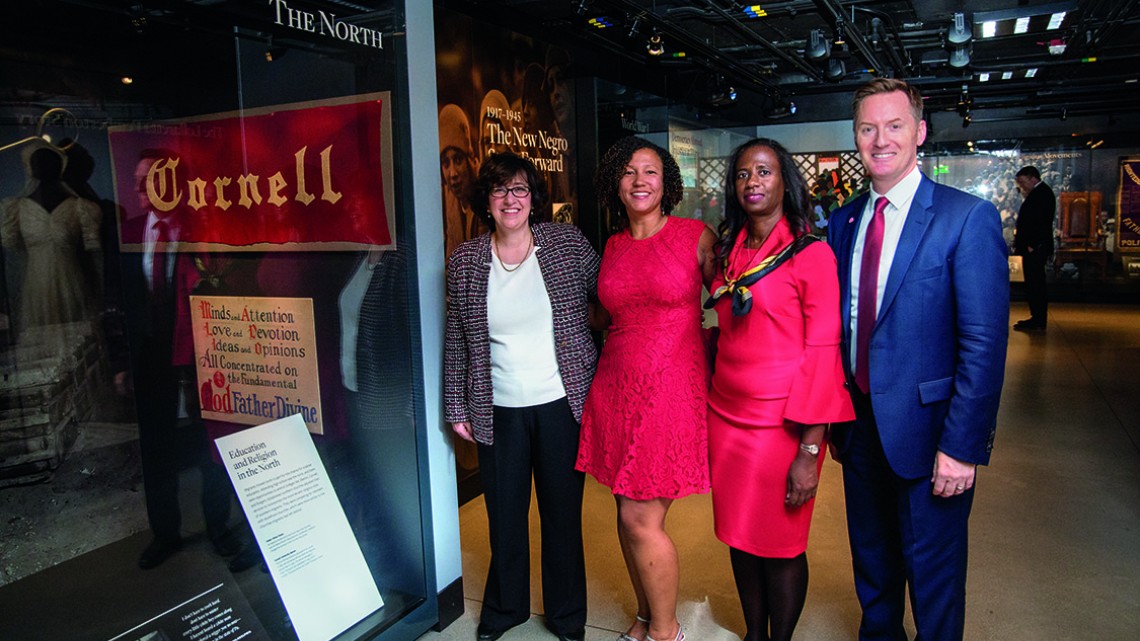
From left, President Martha E. Pollack with volunteers and event drivers Katrina James ’96, alumni-elected trustee; Laura Wilkinson, MBA ’85, J.D. ’86, chair of Cornell Mosaic and a Cornell trustee; and Terry Horner ’92, Ph.D. ’98, president of the Cornell Club of Washington, D.C.
Museum event celebrates African-American history and Cornell connections
By Jose Beduya
It was a celebration of centuries of African-American history, and it sold out within hours. In November 2017, alumni, parents and friends gathered in Washington, D.C., for “Cornell at the National Museum of African American History and Culture,” to explore the exhibits, connect with the Cornell community and affirm the university’s motto of “… any person … any study.”
Cornell President Martha E. Pollack led the gathering. “We can’t be excellent unless we’re diverse,” she said. “I want to reaffirm my own commitment to furthering these inseparable goals of academic greatness and diversity and inclusion.”
The evening also was an occasion to recognize the many ways Cornellians have contributed to the museum and helped tell the story of the struggle against prejudice and oppression, seen from the African-American experience.
A museum of heirlooms
Several artifacts in the museum were family heirlooms, including mementos donated by Cornellians. The weathered Cornell banner in one of the exhibits was once owned by the late Frank Thompson, Class of 1924, and it was donated by his daughters Carolyn Thompson Brown ’65, M.A. ’68, and Judith Thompson Hamer ’60, both retired educators. The banner represents Cornell as one of the first American universities to welcome black students, and it has become a must-see attraction for alumni.
Thompson was a first-generation college student who became a civil engineer in New York City. He taught his two daughters the Cornell alma mater when they were very young and once brought them to Cornell’s campus in Ithaca, where he jotted down their future Cornell graduation years on a blackboard, Hamer recalled.
Thompson’s predictions for his daughters came true, but he could not have foreseen the museum and his beloved banner finding a place in it. “I know that my father would have been breathless, truly amazed,” Hamer said.
Sharing collections, sharing knowledge
Items from Cornell’s archives also augment the museum’s collections. In particular, reproductions of ephemera from the Cornell Hip Hop Collection helped contextualize the musical genre that first exploded from the Bronx in the ’70s.
At the gathering, Cornell also lent the expertise of faculty to guide museumgoers: Kevin Gaines, the W.E.B. Du Bois Professor of Africana Studies; Sandra Elaine Greene, the Stephen ’59 and Madeline ’60 Anbinder Professor of African History; Robert L. Harris Jr., professor emeritus at the Africana Studies and Research Center; Noliwe Rooks, associate professor in the Africana Studies and Research Center and in the Feminist, Gender and Sexuality Studies program; and Penny Von Eschen, the L. Sanford and Jo Mills Reis Professor of Humanities.
A pioneering fraternity
Founded at Cornell in 1906, Alpha Phi Alpha, the first black intercollegiate fraternity, has an extensive presence in the museum. The nationwide brotherhood continues to unite black students and alumni like Eric Elmore ’86, J.D. ’89, president and co-founder of the Cornell Black Lawyers Alumni Network and the alumni chapter president of Alpha Phi Alpha.
“I really take inspiration from those who came before me, particularly the founders of Alpha Phi Alpha who showed that I too can make it at a university like Cornell,” he said.
Elmore is an attorney with the Federal Trade Commission. When he was growing up, Martin Luther King Jr. and Thurgood Marshall – both members of Alpha Phi Alpha – were his heroes. “We stand on the shoulders of so many great people who came before us,” he said.
As a tribute to Alpha Phi Alpha’s founders, Elmore has been spearheading a project to recognize the fraternity’s two original meeting places in Ithaca as historic landmarks.
An investment for the future
Philanthropy has been a bedrock of the museum, and Robert F. Smith ’85 is its second-largest donor. CEO of Vista Equity Partners and a member of Alpha Phi Alpha, Smith believes that the university and the museum are intertwined in their commitment to diversity and inclusivity.
In 2016, Smith and the foundation he directs made a gift to fund chemical and biomedical engineering, with targeted support for African-American and female students, at the College of Engineering. Cornell named the Robert Frederick Smith School of Chemical and Biomolecular Engineering in recognition of his generosity.
“I invest in Cornell because it has always been, and must continue to be, a breeding ground of meritocracy and an incubator for big ideas,” he said in a prerecorded speech at the event. “I’ve invested in this museum because it beautifully and vividly captures the struggles and triumphs of the African-American experience, which is the American experience.”
The Atlantic Philanthropies, a charitable organization established by entrepreneur Charles F. Feeney ’56, also holds a prominent spot on the museum’s list of benefactors.
Service, advocacy and achievement
Military veterans have left their mark on history through their service, and included in the collections are artifacts related to the Tuskegee Airmen, the first African-American pilots who fought in World War II and helped to break down racial barriers in the military. Air crew badges and other mementos owned by Fenton B. Sands ’42, M.S. ’53, Ph.D. ’54, are among those on display.
Community organizers and civil rights activists also feature prominently, including Michael Schwerner ’61, who worked to register black voters in Mississippi in the ’60s. Schwerner and his colleagues, James Chaney and Andrew Goodman, were killed by members of the Ku Klux Klan, and the three are remembered in the museum’s exhibit on the modern civil rights movement. At Cornell, their images are enshrined in a stained-glass window in Sage Chapel.
Alumni luminaries like Nobel Prize-winning writer Toni Morrison, M.A. ’55, and astronaut Mae Jemison, M.D. ’81, appear in the collections, inspiring visitors. As special guests on Cornell’s campus, they also have delivered talks and met with faculty and students, bringing their insights and experiences to the Hill.
At the museum, Cornellians also have contributed behind the scenes: Architects Michael Rantilla ’96, Mark Hill ’84 and Brandon Padron ’02 were involved in the building’s planning and construction; Mindy Magyar ’97 designed the museum’s Sweet Home Café; and Rhea Combs, MPS ’94, is the curator of film and photography and the head of the Earl W. and Amanda Stafford Center for African-American Media Arts.
Building a community, making a difference
The event brought to light another vital component: regardless of creed or color, the Cornellians who come together to make a difference for the university and for their communities.
“It’s not a black museum with black things. It’s really an American story that’s being told,” said Frank Wilkinson ’84, an architect based in New York City and a member of Alpha Phi Alpha and the Cornell Black Alumni Association. “We’re not fighting a struggle only for ourselves. We’re truly fighting the struggle to make America better.”
Ruben Ortega ’13, treasurer for the Cornell Latino Alumni Association and a member of the LGBTQ community, added: “Even though we represent different identities, I think it’s amazing that we can all come together to celebrate our community and recognize the historical artifacts and everything that’s led up to where we are today.”
“Everyone needs an ally, and we’re stronger in numbers and stronger as a community, as one,” he said.
For Terry Horner ’92, Ph.D. ’98, president of the Cornell Club of Washington, D.C., the event was an example of how diverse Cornell groups come together to marshal their forces for greater causes. “We look for intersections where people have overlapping interests, and that’s what this weekend is about,” he said.
Horner praised the community-building work of Cornell staff like those at Diversity Alumni Programs, and highlighted the collaborations among alumni groups like the D.C. Cornell Club, the Cornell Black Alumni Association (CBAA), the Cornell Black Lawyers Alumni Network (CBLAN) and Cornell Mosaic, an umbrella organization for alumni of color and from the LGBTQ community.
Across the United States and overseas, Cornell clubs and associations continue to strengthen their memberships while building ties in their localities. In celebration of Cornell Cares Day in January, for example, groups partnered with nonprofit organizations – from the New York City chapter of Cornell University Gay and Lesbian Alumni Association (CUGALA) helping at an LGBTQ homeless youth shelter, to the Cornell Club of Hong Kong volunteering at a nursing home.
Cornell groups also help raise funds for financial aid, giving underprivileged and underrepresented students the opportunity to enroll and thrive at Cornell. With numerous scholarships like CBAA’s Cornell Tradition Scholarship and CBLAN’s George Washington Fields Scholarship (named after a former slave-turned-lawyer and Class of 1890 Cornell graduate), Cornellians are looking back to the university’s egalitarian founding principles and continuing the story of “… any person … any study” for generations to come.
Get involved with your community of Cornell alumni, parents and friends. Learn more at alumni.cornell.edu.
Media Contact
Get Cornell news delivered right to your inbox.
Subscribe

